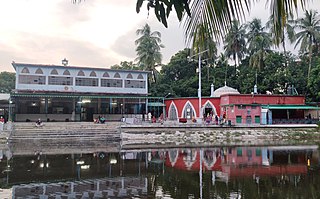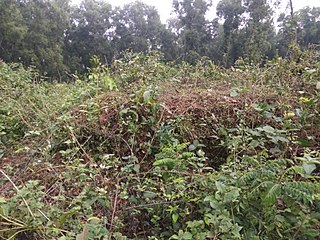
Ghoraghat Upazila, is an upazila of Dinajpur District in the Division of Rangpur, Bangladesh.

Lalpur Upazila is an upazila of Natore District, located the Rajshahi Division of Bangladesh.

Pirganj is an upazila of Rangpur District in the division of Rangpur, Bangladesh. Pirganj Upazila area 411.35 km2, located in between 25°18' and 25°31' north latitudes and in between 89°08' and 89°25' east longitudes. It is bounded by Mithapukur Upazila on the north, Palashbari Upazila on the south, Ghoraghat Upazila and Nawabganj Upazila on the west, Sadullapur Upazila on the east.

Ibrahim Shah Sultan Balkhi, also known by his sobriquet, Mahisawar, was a 16th-century Muslim saint. He is associated with the spread of Islam in Sandwip and Bogra.
Ruknuddīn Bārbak Shāh was the son and successor of Sultan Nasiruddin Mahmud Shah. Initially appointed as the governor of Satgaon during the reign of his father, Barbak ascended the throne of the Bengal Sultanate in 1459. He was the first ruler to give prominent roles in the Sultanate's administration to the Abyssinian community. Historian Aniruddha Ray credits Barbak Shah as the pioneer of urbanisation in Bengal.
Agham Kot, historically known as Agham and today also called Aghamani or Aghamano, is a historical city and present-day ruin site located in Badin District, Sindh, Pakistan. It is located about 1.5 km northwest of the current town of Ghulab Khan Laghari, near the border with Hyderabad District. Said to be named after its 7th-century founder, the Lohana king Agham Lohana, Agham Kot historically lay on the right bank of the Dhoro, a branch of the Indus River that is now dried up. Because of this strategic location on an important waterway, Agham Kot was an important commercial centre in its heyday.

Architecture of Bangladesh is intertwined with the architecture of the Bengal region and the broader Indian subcontinent. The architecture of Bangladesh has a long history and is rooted in Bangladesh's culture, religion and history. It has evolved over centuries and assimilated influences from social, religious and exotic communities. The architecture of Bangladesh bears a remarkable impact on the lifestyle, tradition and cultural life of Bangladeshi people. Bangladesh has many architectural relics and monuments dating back thousands of years.

Shahbaz Khan Mosque is a historic mosque located in Dhaka, Bangladesh. Located near Mir Jumla’s Gate, this mosque serves as an example of late Mughal architecture in Bengal, known as the Shaista Khan architectural style.

Shāh ʿAlī al-Baghdādī was a 15th-century Muslim missionary and Sufi saint based in the Faridpur and Dhaka regions of Bengal.

‘Abd al-Quddūs Jalāl ad-Dīn, best known as Shah Makhdum, and also known as Rupos, was a Sufi Muslim figure in Bangladesh. He is associated with the spread of Islam into the Varendra region of Bengal. He arrived in Bengal with his elder brother Syed Ahmad from Baghdad. Shah Makhdum Airport of Rajshahi, is named after him.

Shah Ismail Ghazi was a 15th-century Sufi Muslim preacher based in Bengal. He came to Bengal in the mid-fifteenth century during the reign of Rukunuddin Barbak Shah, settling in the country's capital, Gaur.

Nasrat Ghazi Mosque is a 15th-century one-domed mosque and archaeological site located in the village of Middle Sialguni in Bakerganj Upazila, part of the Barisal District of southern Bangladesh. The mosque was built during the reign of Sultan Nasiruddin Nasrat Shah.
Khurshid Khan, was an officer of the Bengal Sultanate, stationed across various locations such as Bihar, Sylhet, Dhaka, North Bengal and Chittagong.

The Shah Jalal Dargah is the shrine and burial place of the 14th century Muslim saint Shah Jalal, located in Sylhet, Bangladesh. The site, known as a dargah, was originally constructed c. 1500, though many additions and alterations were made to its structures over the following centuries. It became a religious centre in the region, respected across multiple ruling administrations and greatly venerated among Bengalis, with local folklore and legends developing around it. The extensive surrounding compound serves several functions and includes four mosques, a religious school and a public cemetery among others. The Dargah is presently the largest and most visited religious site in Bangladesh.

Muazzampur Shahi Mosque is a medieval six-domed mosque located in the historic city of Sonargaon, Bangladesh.

Nūr Qut̤b ʿĀlam was a 14th-century Bengali Islamic scholar, author and poet. Based in the erstwhile Bengali capital Hazrat Pandua, he was the son and successor of Alaul Haq, a senior scholar of the Bengal Sultanate. He is noted for his efforts in preserving the Muslim rule of Bengal against Raja Ganesha and pioneering the Dobhashi tradition of Bengali literature.
Shāh Sulaymān Fateḥ Ghāzī al-Baghdādī, or simply known as Fateh Ghazi, was a 14th-century Sufi saint and ghazi who took part in Muslim expeditions in northeastern Bengal. His name is associated with the propagation of Islam in Madhabpur.

Majidbaria Shahi Mosque is a 15th-century one-domed mosque and archaeological site located in the village of Majidbaria in Mirzaganj Upazila, part of the Patuakhali District of southern Bangladesh. It is the oldest mosque and first brick building in the Greater Barisal region having been built during the reign of Sultan Ruknuddin Barbak Shah.

Chaprakot is an ancient site located in the Badarganj Upazila of Rangpur District in Bangladesh, dating back to the 9th-10th century. Locally, it is also known as the Chaprakot Buddhist Monastery or Lohanipara Buddhist Monastery. Four kings from a royal dynasty with the surname Bardhan have been discovered here. An ancient inscription found here is preserved in the Bangladesh National Museum. It is listed as an archaeological site by the Department of Archaeology (Bangladesh).




























